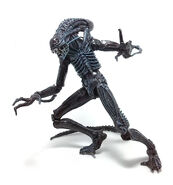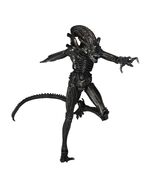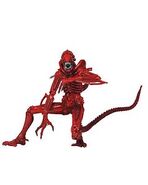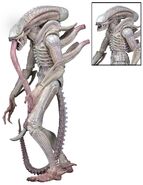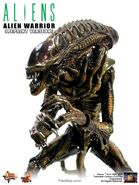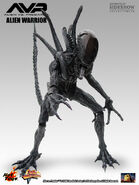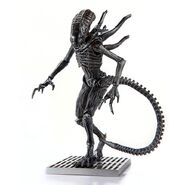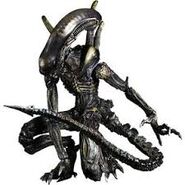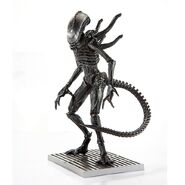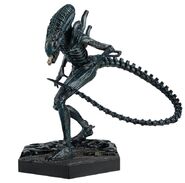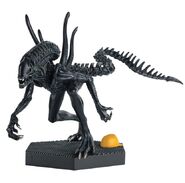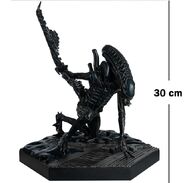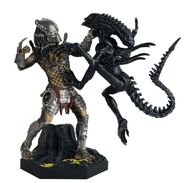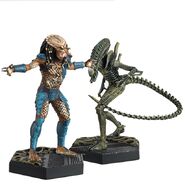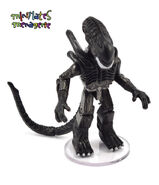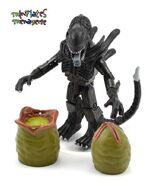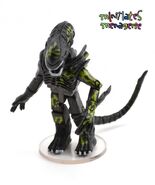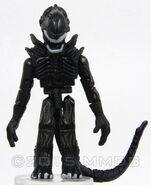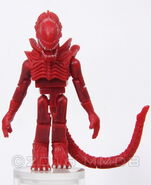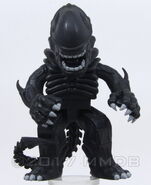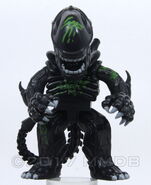 |
"It looks like damage." |
- "With enough force, you might kill one full-grown. Perhaps even several. But in the end, they are, by their very nature, unstoppable. They're too strong. Too vicious. They reproduce and grow too quickly. They're the most versatile living thing in existence. The perfect organism. The ultimate survivor. No matter what you do...All of you are going to die."
- ―Ambrose (from Alien: Revival)
The Drone,[1][2][3][4] also commonly referred to as the Warrior,[1][5][6] Soldier,[1][7] Worker[8] or Lurker,[9][10] and designated a "Stage 4" Xenomorph,[11] is the most common adult form of the species Xenomorph XX121. Between 7–8 feet in height and 14–16 feet long (including their tail), Drones are by far the most widespread caste of Xenomorph, acting as the species' principal offensive unit in combat situations. Among the roles carried out by Drones are the construction of Hives, the elimination of threats and the capture of potential hosts for reproduction.
As with many forms of the Xenomorph, the exact physical characteristics of the Drone can vary; most obviously, the exact makeup of the creature's head carapace has been seen to differ between individuals, with both smooth and ridged examples observed. Other minor differences have also been noted. Drones are fast and reasonably tough, and equally capable of carrying out premeditated stealth attacks as well as engaging in savage close-quarters combat. Even in death the Drone is dangerous, as its pressurized bloodstream will often cause it to burst apart if sufficiently damaged, drenching nearby enemies in acid blood. They are also capable of spitting cysts of this acid at their enemies.[12]
Characteristics[]
- "The size of the Drones depends on the hosts they're born from. Humanoid ones are big."
"How big?"
"A hell of a lot bigger than us." - ―Gabriel Cruz and Lewandowski (from Alien: Bloodlines)
Most Drones that have been encountered have been spawned from human hosts, and as such generally share their host's bipedal stature — although they are known to move equally well on all fours, particularly when climbing walls or ceilings or moving through enclosed spaces, tasks at which they are adept. They are extremely agile, capable of navigating through vents, up walls or across large areas swiftly and nimbly. They also have an astonishing leaping ability. After growing to its full adult height, the Drone typically dwarfs its host, standing at least 7 feet tall when born from a human. They are dark in color, typically black but often with shades of grey,[13] blue or brown[14] across their bodies. They are primarily encountered in offensive situations, being voracious predators possessing notable observational intellect and incredible strength, easily capable of restraining or subduing a physically adept human, lifting a person into the air with little effort, or even breaking down metal pressure doors when in groups.[15] In fact, their physical strength is even rival to that of an adult Yautja.[16][12] As well as their offensive role, Drones are said to fulfil a worker role within the Hive, building and tending to the nest.
The Drone's most distinguishing features are its cylindrical, elongated skull, often more pronounced than on other Xenomorph types. They also possess long, prehensile tails that can be used as a formidable weapon in and of themselves, be it as a blunt flail capable of hurling an average human through the air[13] or as a stabbing weapon able to impale and even suspend a Yautja with little effort.[16] The Drone's additional ability to spit acid makes it able to attack at short distances.[17][12]
When a Drone is killed by weapons that cause massive physical trauma, its highly pressurized bloodstream often causes the creature to explode, showering the surrounding area with molecular acid. This has been seen to cause severe injury and even death to humans caught in such a blast.[14] A similar effect has been seen when a Drone is set aflame, typically through the use of military-issue flamethrowers; the intense heat from prolonged burning can cause the creature to violently explode,[12] which is most likely due to its already high-pressure circulatory system boiling within its body.
While the terms Drone or Warrior are typically used to refer to adult Xenomorphs born from a human host, technically speaking they can refer equally to any basic adult form of the species, including Runners or even Predaliens; these too can be considered "Drones" as they fulfill a similar role in the species' hierarchy, they are merely born from a different host and thus possess different traits as a result of the DNA reflex.
Physical variation[]

A Drone on Acheron. Note the ridged skull.
Physical variation between individuals has been noted with many castes of Xenomorph (most notably Queens), but the trait is perhaps most obvious with the Drone. Aside from the obvious variation between smooth and ridged with regards to the Drone's head carapace, other physical variations have been observed. Examples have been seen with a varying number of digits on their hands. Their segmented tails have been seen to end in both a stinger-like barb[13] and a blade-like tip that can be used to propel the creature swiftly through water.[12] Some Drones have also been seen to possess blade-like protrusions at the elbows.[14]
The exact cause of this variation — or whether it serves any specific purpose — is unclear. It has been noted that the differences are not necessarily "hereditary" with regards to a single lineage of Eggs; the Eggs aboard the derelict on Acheron spawned both smooth and ridge-headed Drones in separate encounters. Factors such as aging have been proposed as the cause of the differences, but evidence supporting this is far from conclusive.
Intelligence[]
During the course of his limited research into the species, Ash theorized that the Drone is at least as smart as a dog, and probably more so than a chimpanzee.[18] Drones have been seen to substantially modify their combat tactics dependant on their situation. For example, they have been known to employ ambush strikes and stealth as well as open, full-frontal assaults; the use of one over the other may simply depend on the strength in numbers available to them, as the latter has typically been seen only when dealing with large swarms of Drones. During pitched combat, some Drones have been known to continue fighting, or at least attempt to do so, even after losing one or more limbs.[3][12]
When operating stealthily, Drones have been known to be intelligent and patient, often seeking to blend in with their environment and waiting motionless for their prey to come within range before striking.[13][14] Conversely, they have also been known to employ direct assaults and swarm attacks, using sheer weight of numbers to overwhelm defenses and subdue their prey. While this behavior often leads to high casualty rates against prepared opponents, it brings with it distinct psychological advantages with regards to enemy morale.[14] It is not clear to what degree these more reckless swarm attacks represent a diminished intelligence in certain groups, an intelligent response to given situational factors, or the result of influence from a resident Queen. It seems highly likely that Drones do not require the leadership of a Queen to function at an intelligent level, but are overwhelmingly driven by the Queen's commands when one such organism is present. Essentially, a solitary Drone is capable of making independent decisions, but a group operating under the leadership of a Queen are bound by her higher commands.
It also seems that intelligence and mental capabilities can vary from one individual Drone to another. In some cases, certain individuals have seemingly possessed greater intelligence than their brethren, and have even been seen to act as a "leader" amongst a group of Drones. Notable examples include Grid[16] and the Lead Alien aboard the USM Auriga.[19]
Evolution[]
Drones have an ability to evolve into other higher forms of Xenomorph, such as Praetorians and, eventually, Queens. The conditions that may initiate these changes are not well understood with situational, environmental, and hierarchical factors being quoted in different sources. The exact mechanism by which these changes occur are uncertain.
Variants[]
Domed variant[]
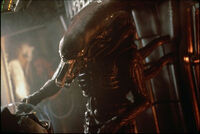
A Drone with a domed carapace aboard the Nostromo.
The first of the two most commonly encountered forms of Drone are those with smooth, domed skulls. Such Drones were notably encountered beneath Bouvet Island in Antarctica, on the USCSS Nostromo, on Sevastopol Station, and on the USM Auriga (albeit as a mutated strain).
Ridged variant[]

A Drone with a ridged carapace on Acheron.
The second of the two most commonly encountered forms of Drone are those with ridged skulls. Although, there is no true "standard" Drone (due to the highly variable nature of Xenomorph physiology), examples with ridged skulls are almost certainly the most commonly encountered of all Drones. Notable encounters with such creatures include Acheron, Charon Base, BG-386 and LV-1201.
Carved variant[]
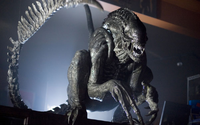
A Carved Drone on Earth.
While many Drones already possesses a ridged skull, a more rugged version, referred to as "Carved"[6] is known to exist.[20] It is thought that the additional, more substantial ridges may afford them additional resistance to damage.[6] The only known encounter with the Carved variant was in Gunnison, Colorado in 2004.
Elite Guard[]
- Main article: Elite Guard
The Queen Mother's chosen protectors[21] or "chosen few"[22] were first encountered on a mission to recover the Queen Mother from the purported Xenomorph homeworld. Emerging from the five egg-like pods connected to the Queen Mother's central pod, a chosen protector was described as a "Queen-sized Drone" [23] and possessed a pair of fang-tipped protrusions on each side of the head. Faster than the Xenomorphs encountered on Earth, the chosen protector was capable of tearing through the alloyed steel of a Power Loader.[24]
Biodrone[]
- Main article: Biodrone
The Xenomorph XX121B Biodrone was an artificially produced Xenomorph Drone created by the United Americas. They are physically indistinguishable from normal Drones, albeit with genetic modifications installed by the UA with the desire to turn the Xenomorph into a more convenient bioweapon. Biodrones are unable to evolve any further beyond their Stage IV 'Drone' form and have an expected lifespan of six days.[25]
Behind the Scenes[]
Drone vs. Warrior[]
One common misconception is that the "Drone" and "Warrior" are distinct castes within the Xenomorph hierarchy, with the former being the creature seen in Alien and the latter those seen in Aliens. However, this concept is not borne out by the script or design intentions for the second film, and is largely a legacy of the expanded universe of comic books and games as well as fan speculation.[26]
Much of the confusion seems to stem from the use of the word "warrior" to describe the Xenomorphs in the second film, coupled with their altered appearance. However, as director James Cameron explained in an 1987 issue of Starlog magazine, "warrior" was simply "my term for the single adult seen in Alien", going on to state that the creatures in his film possess "the same physical powers and capabilities" as the Alien in the original movie.[26] Notably, Cameron's use of the word warrior to describe the Xenomorph originated in the film's script long before the specific aesthetic changes to the creature — most obviously the removal of the smooth carapace on the head — ever came into being.
Nevertheless, the idea that Xenomorphs with smooth skulls are Drones while those with ridged skulls are Warriors has persisted. However, it can be seen that the distinction between the two has never been particularly clear-cut in the franchise. For instance, the Xenomorphs in the video game Aliens versus Predator 2 are referred to as Drones, despite having ridged heads like those in Aliens. Similarly, merchandising for the film Alien vs. Predator refers to the creatures in the film as Warriors, despite the fact they possess a smooth carapace. While in Aliens: Fireteam Ellite, The Drone and Warrior are two distinct Boss types, with the former sporting a domed carapace and the latter a ridged variant. The official reference book Alien: The Weyland-Yutani Report has since made it clear that both smooth and ridge-headed Xenomorphs are simply variations of Drone.[2] In essence, the two terms are entirely interchangeable.
Drones and Warriors[]
However, more recent sources, such as Alien: The Roleplaying Game and Alien vs Predator: The Hunt Begins, makes a clear distinction between them as different stages of the same metamorphic line. Drones are referred to as "Stage IV" Aliens and are intended to be "young adult" forms of the Xenomorph, similar to the Runner alien. Some sources even refer to Drones as "infants"[27] and distinguishes them from the adult Warrior Xenomorphs through function in the hive and a neural independence. This failure to establish a strong connection to the hive mind makes the drone awkward, but capable of plotting and scheming.
Drones are also, uniquely, capable of "Ovormorphing" victims into alien eggs when isolated from the hive.[28]
Xenomorph drones will arrest their development at stage 4 until the pheromones from a Queen instruct them to evolve into a Warrior or Worker organism, both considered stage 5 Xenomorphs. Either evolution sees it neurally joining the hive mind. At this point, they are considered full adult Xenomorphs and are physiologically distinct from the Drone by developing elbow spines, a ridged dome, a harder carapace, and the rudimentary barb on it's tail end turning into a proper blade.[29]
The Aliens redesign[]
When it came to filming the sequel to Alien, director Cameron wanted to update the titular creature's design, reshaping it for war whilst at the same time staying true to the Alien seen in the first film.[30] Of the alterations to the design, special effects designer Stan Winston commented, "We tried to be as true to the original film as we could, without disallowing ourselves a little bit of artistic freedom to do things that we considered — if not improvements — something to keep your head above water, so you're not just doing what was done before."[31] Given that the original creature's designer H. R. Giger was busy working on Poltergeist II, Cameron chose not to pursue him for his input, a decision that upset Giger at the time.[31]
The most obvious design alteration from the first creature was the removal of the domed carapace. Originally, the Drones in the second film were to have domed heads like the original Alien; an early prototype was built with just such a carapace, but Cameron's fears that the fragile dome would crack during filming and cause delays led to it being removed. Cameron also confessed to preferring the ridged design created by Winston's team, which was originally to be partially concealed beneath the dome.[30] As the removal of the dome meant the Alien's skull would be exposed, the human eye sockets located in the front of the original creature's head — but largely concealed beneath its dome — were also removed, in order to preserve what Winston dubbed "the Alien's eyeless menace".[31] However, not every trace of the sockets was deleted, and upon close inspection, small indentations can be seen in the front of the Warrior's head. Other more subtle changes to the Warrior included longer talons on the hands, altered feet more suited to the creature's new wall-climbing abilities and blade-like protrusions on the creature's elbows.[31]
Suits and puppets[]

Example of how selective lighting and shadow was used to hide the comparatively crude suits used in Aliens
Immediately recognizing the limitations of the suit used in the first movie — in particular its expense and restricted range of movement — Cameron and Winston chose to adopt a far simpler approach for the second film. Thus the majority of the Xenomorphs in Aliens were created from flexible latex body suits with Xenomorph appliances affixed over the top.[32] This allowed the stuntmen playing the creatures to be far more mobile and aggressive in their movements. Selective camera angles and careful lighting were then used to hide the relatively crude suits, the emphasis being on merely suggesting the look and shape of the creature rather than over-exposing it. As a result, the dark body suit remained hidden in shadow, with only the highlights of the Xenomorphs' exoskeleton visible in the strobing lights and muzzle flare.[30] Thanks to the new highly mobile outfits, shots of the Xenomorphs bounding along walls and through airshafts — ideas originally planned for Alien but dropped due to the limitations of the film's suit — could be realized in the sequel.[30] Due to budget limitations, the production could only afford to build twelve Warrior suits.[33]
The Warrior suits were crafted and constructed by Tom Woodruff, Jr., John Rosengrant, Julian Caldow, Nigel Booth, Lindsay McGowan and David Keen.[31] As well as these simple suits, a number of far more detailed plastic and foam rubber examples were created for the shots where the creatures are seen more clearly.[32] For particularly violent scenes of Warriors being blown to pieces by gunfire, static models were used and fitted with pyrotechnic charges that would release chemicals simulating the creatures' acid blood.[32] Lastly, a completely articulated upper torso with mechanical lips, tongue and jaw was built for close-ups.[34]
The making of a Warrior[]
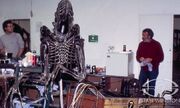
Behind the scenes image of the articulated Warrior puppet.[31]
In the image to the right, creature creator Stan Winston and his lead FX mechanic, Richard Landon, prepare the hero Alien Warrior puppet for its debut on set at Pinewood Studios. To make the cable-actuated Xenomorph puppet more maneuverable, the SWS crew loaded the cables and controllers onto a wagon so they could quickly reposition the cable-controlled Alien to perform wherever director James Cameron wanted it to.
Unlike the slow-moving horror of the original Alien from Alien as established by Ridley Scott, Cameron created a film in which the Xenomorphs would be fast, active and dynamic. To achieve the range of action and mobility required by Cameron's vision, the Stan Winston Studio team created many different versions of the Aliens depending on whatever the shot called for: hero insert puppets with articulated upper torso, mechanical lips, tongue and jaw for closeups; lightweight black "Alien" leotards covered in polyfoam for stunt performers to wear in action shots; and poseable alien warrior figures for blowing up, setting on fire, running over and for stunts too dangerous for stuntmen to perform.
In the final film, even though Stan Winston and his team only built 12 Warrior suits, Cameron managed to create the illusion of "an entire army", and make FX history, by "using every trick in the book."[35]
Trivia[]
- One popular theory that attempts to explain the variation between Xenomorphs with a smooth carapace and those with a ridged skull postulates that the development of ridges is linked to maturity, as the creatures in Aliens are several weeks older than the Alien in the first movie (a theory Cameron himself labelled "as good as mine"[26]).
- The Drone in the novelization of Alien has a slightly different design to the version seen on screen, including large eyes on the front of the head[36] (similar to H. R. Giger's original painting). It also notably lacked an inner jaw, instead using its bare hands to kill its victims.
- A different type of Xenomorph identified as a "Drone" was originally going to appear in Aliens. These Drones were going to be much smaller than the "Warriors" seen in the film and white in color, with an excreting probe in place of the inner jaws. They were to be a worker caste inside the Hive, tending to the Queen and moving her Eggs.[37] They were ultimately cut from the movie before filming, although they appeared in the novelization by Alan Dean Foster.[38] While their attributes have since been applied to the Drone from the movies, the original albino caste had yet to appear in any other media until the release of the 2021 novel Aliens: Infiltrator, featuring the novel's albino super-drone on its cover.
- In the 2010 video game Aliens vs. Predator, the Drones make the same sounds as Chestbursters. This is most readily heard when playing as a Yautja and a trophy kill is performed on a Drone.
- Although the Aliens: Colonial Marines official strategy guide stated that the Lurker and Drone were separate castes,[citation needed] this was later retconned, with the Alien RPG Handbook stating otherwise.[citation needed]
- The Ravager is a massive alien that closely resembles the ridge-headed Drone. However, it spawns from the Praetorian line.
- The "Soldier" in Aliens: Colonial Marines has a golden brown tint as well as a glossy carapace. It's also worth noting that while they are not the largest in body, soldiers have the largest canine teeth of Colonial Marines' humanoid Xenomorphs.
- When questioned if the Xenomorph on the front cover of the Alien: The Cold Forge novel was a visual representation of the Chimp Alien, author Alex White clarified it was not. It is actually a "Soldier" Xenomorph from the 2013 video game Aliens: Colonial Marines.
- A Drone was part of the first cinematic crossover between the Alien and Predator franchises when a ridged Drone's skull appeared in the trophy cabinet aboard the Mother Ship near the end of Predator 2. The skull was included at the suggestion of effects artists John Rosengrant and Shane Mahan, both of whom had worked on Aliens as well as Predator 2. They proposed the idea as something of a joke, and also as a nod to the original Aliens vs. Predator comic, which had been published earlier in the year.[39]
Gallery[]
Notable Drones[]
Behind the scenes[]
Figures[]
See also[]
- Palatine - a similar type of Xenomorph, but the size of a Queen.
References[]
- ↑ 1.0 1.1 1.2 1.3 1.4 Weyland-Yutani Archives (2008), 20th Century Fox [Blu-ray]
- ↑ 2.0 2.1 S. D. Perry. Alien: The Weyland-Yutani Report, p. 20 (2014), Insight Editions.
- ↑ 3.0 3.1 Aliens versus Predator 2, Microsoft Windows version, Monolith Productions, 2001.
- ↑ Alien (comic)
- ↑ Alien Legacy trading cards — 69. The "Aliens" Warrior (1998), Inkworks.
- ↑ 6.0 6.1 6.2 AVP: Evolution, Mobile version, Angry Mob Games, 2013.
- ↑ Aliens: Colonial Marines, Microsoft Windows, PlayStation 3, Xbox 360 version, Gearbox Software, 2013.
- ↑ Lee Brimmicombe-Wood. Aliens: Colonial Marines Technical Manual, p. 155 (2012), Titan Books.
- ↑ Aliens: Colonial Marines
- ↑ Alien: The Roleplaying Game P.308
- ↑ Alien: The Roleplaying Game
- ↑ 12.0 12.1 12.2 12.3 12.4 12.5 Aliens vs. Predator, Microsoft Windows version, Rebellion, 2010.
- ↑ 13.0 13.1 13.2 13.3 Dan O'Bannon, Ronald Shusett (writers), Ridley Scott (director). Alien (1979), 20th Century Fox [DVD].
- ↑ 14.0 14.1 14.2 14.3 14.4 James Cameron (writer and director). Aliens (1986), 20th Century Fox [DVD].
- ↑ James Cameron (writer and director). Aliens Special Edition (1991), 20th Century Fox [LaserDisc].
- ↑ 16.0 16.1 16.2 Paul W. S. Anderson (writer and director). Alien vs. Predator (2004), 20th Century Fox [DVD].
- ↑ Vincent Ward (writer), David Fincher (director). Alien3 (1992), 20th Century Fox [DVD].
- ↑ Alan Dean Foster. Alien, p. 240 (2014), Titan Books.
- ↑ A. C. Crispin, Kathleen O'Malley. Alien Resurrection, p. 128 (2015), Titan Books.
- ↑ Shane Salerno (writer), The Brothers Strause (directors). Aliens vs. Predator: Requiem (2007), 20th Century Fox [DVD].
- ↑ Aliens: The Female War
- ↑ Aliens: Female War
- ↑ "A queen-sized drone, bigger than any Wilks had ever seen..." p. 143 Aliens: The Female War
- ↑ Aliens: Female War
- ↑ Colonial Marines Operations Manual P.176
- ↑ 26.0 26.1 26.2 "Strange Shapes - The Drone Distinction". Retrieved on 2018-11-01.
- ↑ https://shop.prodosgames.com/alien-vs-predator/201-avp-alien-infants.html
- ↑ Alien: The Roleplaying Game
- ↑ Alien: The Roleplaying Game
- ↑ 30.0 30.1 30.2 30.3 "Strange Shapes - Biomechanoids". Retrieved on 2014-10-24.
- ↑ 31.0 31.1 31.2 31.3 31.4 31.5 "Monster Legacy - StarBeast — Aliens". Retrieved on 2015-02-24.
- ↑ 32.0 32.1 32.2 Gale Anne Hurd, Sigourney Weaver, Michael Biehn, Bill Paxton, Stan Winston, John Richardson. Superior Firepower: Making Aliens (2003), 20th Century Fox [DVD].
- ↑ Jody Duncan. The Winston Effect: The Art and History of Stan Winston Studio, p. 85 (2006), Titan Books.
- ↑ Jody Duncan. The Winston Effect: The Art and History of Stan Winston Studio, p. 88 (2006), Titan Books.
- ↑ https://www.stanwinstonschool.com/blog/aliens-movie-the-making-of-a-xenomorph-drone
- ↑ Alan Dean Foster. Alien, p. 214 (2014), Titan Books.
- ↑ "Alien II" initial treatment by James Cameron
- ↑ Alan Dean Foster. Aliens, p. 304 (2014), Titan Books.
- ↑ Jody Duncan. The Winston Effect: The Art and History of Stan Winston Studio, p. 120 (2006), Titan Books.
- ↑ Alien Anthology - The Anthology Archives - Aliens - Production - Photography - Stan Winston's Workshop
- ↑ https://www.facebook.com/photo.php?fbid=177521885774448&set=a.177200059139964.1073741828.177187029141267&type=1&theater
- ↑ https://www.facebook.com/photo.php?fbid=177626332430670&set=a.177200059139964.1073741828.177187029141267&type=1&theater

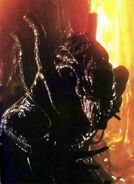
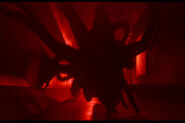
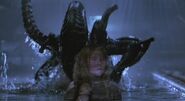
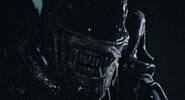
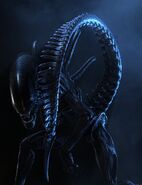

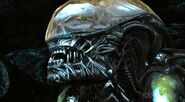
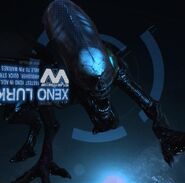
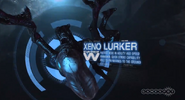
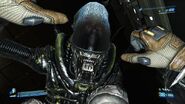
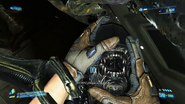
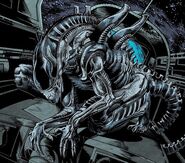
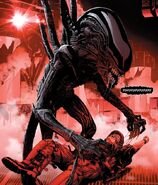

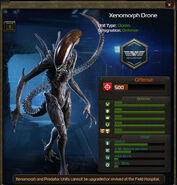



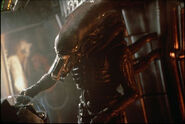
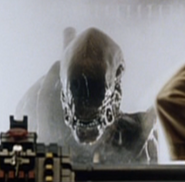

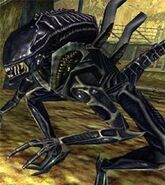
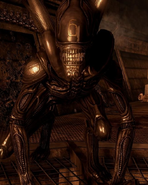
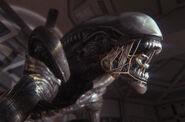
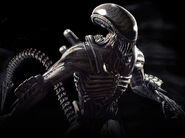
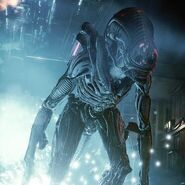
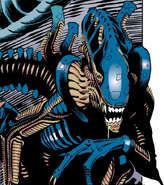


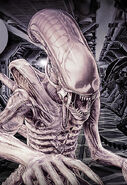

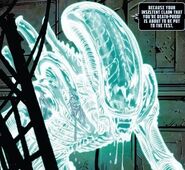
![1382313 177521885774448 2113354240 n.jpg (35 KB) An original full rubber costume for Aliens,[40] before slime was added and the suit was made dirty for filming.[41]](https://static.wikia.nocookie.net/avp/images/8/89/1382313_177521885774448_2113354240_n.jpg/revision/latest/scale-to-width-down/167?cb=20131024012548)
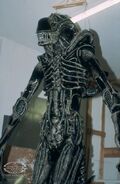
![1375329 177626332430670 58260669 n.jpg (82 KB) One of the original costumes from Aliens which was sold at an auction.[42]](https://static.wikia.nocookie.net/avp/images/3/3b/1375329_177626332430670_58260669_n.jpg/revision/latest/scale-to-width-down/136?cb=20131024011857)



